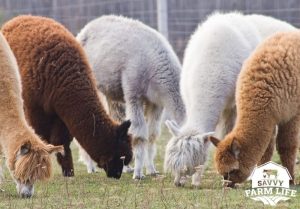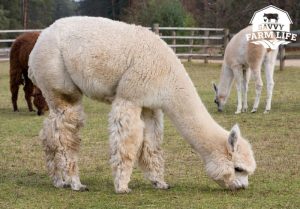
How Much Do Alpacas Weigh?
Alpacas make wonderful pets, with their small sizes and relatively low-maintenance care. If you are researching alpacas to determine whether they would fit in with your lifestyle, you are likely curious about their mature size and dietary needs.
So how much do alpacas weigh, and how big do they get? Alpacas are one of the smallest members of the camelid family, and a mature alpaca will usually weigh between 120 and 185 pounds. This is much smaller than their Llama cousins, which makes alpacas easier to handle and manage. It is important to understand what a healthy weight is for your alpaca, and to regularly score your alpaca’s body condition to determine how their diet may need to be altered.
Being able to recognize a healthy weight and weight problems in your alpacas and take the necessary action will help to keep your alpacas healthy. To learn more about maintaining alpaca weight, read on!
Male vs. Female Alpaca Weight
It is recognized that a weight range of 120 – 200 pounds is normal for healthy, mature alpacas, though 120 – 185 is typically the ideal range. As for height, a mature alpaca will have a height of about 36” at the shoulder. But which is bigger – male or female alpacas?
As is the case with llamas, there is no significant difference in size between male and female alpacas. Both males and females mature to roughly the same size and weight. While there is no difference in size at maturity, the age of maturity may differ between the two genders. Females are considered fully grown and sexually mature at 8 – 12 months, though it is not recommended that females be bred until they are closer to 2 – 3 years of age. Male alpacas, on the other hand, are considered fully grown and sexually mature at 2 – 3 years of age.
Baby Alpaca Weight
Baby alpacas are called crias. Like many large mammals, crias are able to stand and walk within minutes of birth. Crias can weigh anywhere from 8 to 22 pounds, though the ideal and average weight of a cria is between 15 and 20 pounds. If you are breeding your alpacas, it is important to note the weight of your crias as they are born so that you can monitor their weight and ensure that they are growing appropriately.
Huacaya vs. Suri Alpaca Weight
There are two different breeds of alpaca – the Suri and the Huacaya. The main difference between the two breeds is their fleece. Huacaya alpacas have a fluffy and springy fleece, similar to that of a sheep’s. Their fleece is crimped and is approximately 3 to 5 inches long. Suri alpacas have long, flowing fleece that is similar to mohair. The Suri’s long fleece is roughly 4 to 7 inches long and not crimped like the Huacaya’s. Huacayas make up around 90% of the alpaca population in the US, while Suris make up only around 10%.
So is there any difference in size between the Huacaya and the Suri? While many assume that the Huacaya is larger than the Suri, this is largely because of the way the fleece grows. There is no difference in weight or body structure between the two breeds, but the way the fleece of the Huacaya fluffs up and out gives it the appearance of being larger. Shear the two breeds side by side, and you will see there is actually no difference in size.
Do alpacas spit like their Camelid cousins? To learn more, visit my article Do Alpacas Spit? Everything You Need to Know.
Should You Weigh Your Alpaca?
Two instances that you will want to weigh your alpaca are when you have a cria, and when you are attempting to determine the correct medication dosage for one of your alpacas. For ongoing health maintenance in mature alpacas, what is even more important than weight is body condition scoring. What is body condition scoring?
Body condition scoring is an essential skill if you have livestock or horses, and is the act of palpating the animal in specific areas to determine how much fat the animal is storing.
Body Condition Scoring In Alpacas
 To score your alpaca, you will want to focus on two areas. The first area is the mid-back, or the top of the back directly equally in between the neck and the tail. Because males, older, and younger alpacas may carry weight and muscle around their spine differently, it is also important to feel where the last of the ribs are located as well, on the alpaca’s side.
To score your alpaca, you will want to focus on two areas. The first area is the mid-back, or the top of the back directly equally in between the neck and the tail. Because males, older, and younger alpacas may carry weight and muscle around their spine differently, it is also important to feel where the last of the ribs are located as well, on the alpaca’s side.
You will palpate these two areas, and will give a score between 1 and 5 (though some use a scale of 1 to 10). 1 will be very skinny, with the spine protruding and your fingers fitting easily between the ribs. 5 is very obese, with so much fat that you are unable to feel the ribs at all. With an overweight or obese alpaca, you will also begin to find pads of fat under the tail and at the chest.
The ideal body condition score for a healthy, mature adult alpaca is between 2.5 and 3. An alpaca that is younger than 15 months should score around 3, and a female in late pregnancy should score between 3 and 3.5.
While you may be uncertain about scoring the first couple of times you attempt this, it will become easier as you palpate more alpacas and become familiar with the process. It may also be helpful to watch a video the first time you use this method.
Overweight Alpacas
An overweight or obese alpaca can be more susceptible to a host of diseases and health complications, just as in other animals. Older alpacas are more likely to become obese than younger alpacas – their activity level will slow down as they age, while their caloric intake may remain the same. If your alpaca is beginning to show signs of obesity, you will want to adjust their feeding and keep an eye on body condition more frequently.
Underweight Alpacas
Alpacas might become underweight for a variety of reasons. If your older alpaca is losing weight, you will want to check his or her teeth. As alpacas age, their teeth wear down and pieces can break off. If you notice your older alpaca chewing a wad of cud and not swallowing it, this may be a sign that she is not able to break it down with her teeth. Likewise, if her teeth are broken and sharp, or overgrown, this may be causing her pain while chewing. If you suspect your alpaca has teeth issues, it is important to get these taken care of by a vet so that he or she can comfortably eat. Offering soaked hay pellets or chopped hay may help the senior alpaca who has missing teeth or other dental problems.
Your alpaca may also be underweight due to food competition. Alpacas have a delicate social hierarchy, and you may see your low man on the totem pole begin to show signs of being underweight. If this is the case, he may not be able to eat enough before the rest of the herd finishes the hay. You may need to keep an eye on the herd in this situation and ensure that your underweight alpaca is getting enough food. It may even be necessary to feed him separately from the rest of the herd.
Mother alpacas, or dams, with crias may also become underweight due to the additional nutritional demands on her body to produce milk. You will want to supplement her feed and offer a blend of at minimum 14% protein to help her replenish her weight.
Weight Of Other Camelids
Alpacas are one of six members of the camelid family – the other five being the llama, the guanaco, the vicuna, the Bactrian Camel, and the Dromedarian Camel. How does the alpaca’s weight compare to those of it’s relatives?
The guanaco and the vicuna are the closest relatives to the alpaca in terms of size. Vicunas are the smallest members of the camelid family, averaging around 110 pounds at maturity, while guanacos usually weigh between 200 and 300 pounds.
Llamas, like alpacas, are often kept as pets and as livestock guardians (To learn more, check out my article What Are the Best Livestock Guardian Animals?). The biggest difference between the two is size. While the alpaca weighs between 120 and 185 pounds, llamas average 250 to 450 pounds at maturity. If you think that sounds big, let’s take a look at camels. Dromedarian Camels are found in Africa and are what most of us think about when camels come to mind, with their characteristic one hump. Dromedarian Camels average 880 to 1320 pounds at maturity. Bactrian Camels are found in China and Mongolia, and have 2 humps. Bactrian Camels are the largest members of the camelid family, maturing to between 1000 and 2200 pounds.
Weight Fluctuations
An alpaca’s weight may fluctuate throughout his or her life, and so dietary changes may become necessary as an alpaca ages or goes through physiological changes like pregnancy. It is important to not rely on weight alone, as body condition will be more important in determining health in your alpaca. Some alpacas may be larger boned than others, or more heavily muscled. If you are regularly checking your alpaca’s body condition, you will be able to more accurately determine the health of your animal and whether any dietary adjustments need to be made.
Managing your alpaca’s weight is just one skill you’ll need when it comes to caring for alpacas. To learn what all goes into raising these animals, visit my article Are Alpacas Hard to Care For? Alpaca Care Essential Guide.
